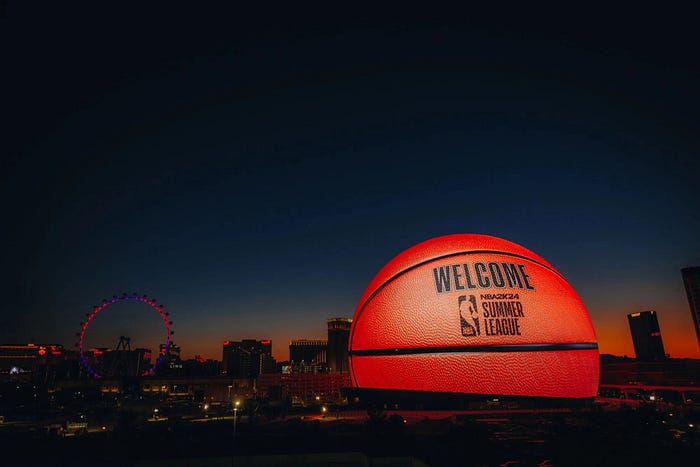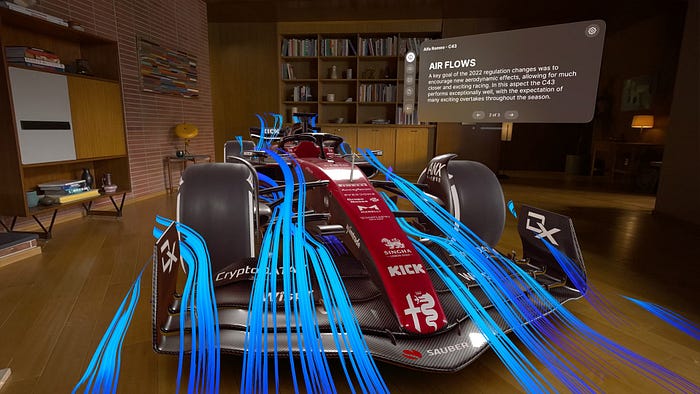The Las Vegas Sphere: a new horizon in immersive experience design
In an intersection of digital and physical, the dome-shaped building provides an awe-inspiring multisensory experience and pushes the boundaries of audience engagement, architecture, technology, and design.

The Las Vegas skyline has been forever transformed by the addition of a massive, awe-inspiring structure. The Sphere at The Venetian Resort, the latest project of Madison Square Garden CEO James Dolan, marks a new era in immersive experiences. The gargantuan building, lined with a fully-programmable LED lighting exterior, paints an enchanting picture of life-like images visible from miles away, and opens a world of new possibilities in the realm of experiential entertainment.
A Sphere Like No Other

Once fully completed, the Sphere will stand as the world’s largest spherical structure at an impressive 415 feet wide by 366 feet tall. The exterior, which is already finished and garnering widespread attention for its creative displays, only tells part of the story. The interior, still under construction, promises an experience that will mirror and surpass the exterior’s captivating spectacle.
Designed to be an entertainment hub, the interior features a wraparound 16K resolution fully-programmable LED screen. At 160,000 square feet, it is set to be the world’s largest and highest-resolution screen of its kind. Externally, the Sphere boasts 580,000 square feet of screens, crafted to deliver a captivating visual display.
This not only allows for an extraordinarily immersive viewer experience, but it also enables the building to transform into spectacular themes. Beyond the basketball-themed spectacle for the NBA Summer League and the 4th of July showcases we’ve already witnessed, imagine the structure morphing into a colossal glittering disco ball for the New Year, or a twinkling Christmas snow globe dominating the Las Vegas skyline.
A New Era of Entertainment
The Sphere’s conception required significant innovation. Sphere Studios had to develop a unique camera system, known as Big Sky, which boasts a single 316-megapixel HDR image sensor. For context that’s around 40x more resolution than 4K cameras.
The team also developed their own image processing software for Big Sky called SphereLab, harnessing GPU-accelerated RAW processing to ensure practical workflows for capturing and delivering content to the Sphere’s screen.
Coupled with a state-of-the-art sound system, capable of delivering sound through the floorboards, and 4D features like scent and wind, the Sphere offers a multisensory experience unlike any other. It’s designed to host awards shows, concerts, esports tournaments, and even ring sports events such as boxing and MMA.
The Sphere’s programming promises to be as boundary-breaking as its construction. Upcoming events include a residency by U2 that is promised to be a “quantum leap forward” for live performance, and an immersive production by director Darren Aronofsky (Black Swan, The Wrestler, The Whale).
“At its best, cinema is an immersive medium that transports the audience out of their regular life, whether that’s into fantasy and escapism, another place and time, or another person’s subjective experience. The Sphere is an attempt to dial up that immersion,” Aronofsky says.
Beyond these events, the Sphere represents a wealth of opportunities for the entertainment industry, particularly across sports, esports, music and film.
The Intersection of Entertainment and Extended Reality Design
This expansion into immersive experiences isn’t confined to the Sphere. Companies, particularly Meta (Horizon Worlds, Progress in XR), Microsoft, Sony (PlayStation VR2, Extended Reality R&D), Google and Apple (Vision Pro, visionOS) are making big bets on extended reality.

Across the industry, designers are leveraging emerging technologies in extended reality (XR) — an umbrella term including augmented reality (AR), virtual reality (VR), and mixed reality (MR) to create innovative products.
Spatial experience design, the practice of arranging physical or virtual spaces for optimized functionality and user experience, is pivotal in this shift. Designers are increasingly required to think beyond traditional dimensions, creating experiences that incorporate familiar elements but in remote or digitally reinvented forms.
Virtual environments, such as those offered by the Sphere, bring an added layer of creativity and narrative. They can be designed to offer more than just the contents they display, creating truly immersive and intellectually stimulating experiences.
A Canvas of Possibilities
Having a space of this nature opens up nearly endless possibilities for experience design and audience entertainment.
- Historical transformations could be represented in an immersive, combined inside-out spectacle. The exterior of the Sphere could showcase a globe fast forwarding through Earth’s history — volcanic eruptions, continental shifts, the emergence of civilizations, and the evolution of modern cities — while the interior could transport audiences into different eras, providing a time-traveling experience.
- Expanding into the realm of interactive gaming, the Sphere could host a colossal multiplayer game that engages both the inside audience and outside observers. Each participant could control a part of the overall display, collaborating to achieve shared goals or competing in teams, thus blending the boundaries between spectators and performers.
- A concept could involve spectators virtually “painting” the exterior of the Sphere with digital graffiti, using virtual spray cans. Inside, audience members could witness the creation of this live graffiti art on the building’s exterior while also interacting with their own immersive artistic displays.
- Picture the Sphere transforming into an astronomical wonder. Its exterior could manifest as a planetarium, showing the movements of stars and planets across the Las Vegas sky. Meanwhile, inside, the audience would be taken on a journey through galaxies, stars, and even black holes, offering an unrivaled, immersive space exploration experience.
These interactive ideas could transform the Sphere from just a display screen into a participatory experience, enhancing both passersby's and the audience’s engagement and creating unique, memorable moments.
Building for The Future: Implications for Designers
The Sphere represents the epitome of spatial experience design and extended reality — two elements that are shaping the future of product design. The blending of digital and physical realities is set to be a significant trend in design.
A New Design Canvas: The current pace of extended reality itself represents a paradigm shift from flat to spatial design, which will require designers to incorporate a sense of space, depth, and immersion into their designs. Designers already have access to visionOS resources and will be creating for Apple Vision Pro as part of a normal workflow before it arrives Q1 2024. This will mean thinking beyond conventional flat interfaces and envisioning designs that can interact and evolve within a three-dimensional space.
Another recent example of this is the Humane AI Pin, shown in a TED talk demo by Imran Chaudhri where he imagines a vision for a world without devices.
Audience Engagement: As a designer, the challenge will lie in creating such meaningful and engaging experiences within your products that allow users to feel part of the narrative rather than just passive observers. This may become the standard product experience before long.
Immersive Storytelling: The Sphere will show how large-scale, immersive designs can create powerful narratives, stirring emotions, and facilitating deeper connections with users. Storytelling will thus become a crucial skill for designers, providing a narrative context that enhances the overall user experience.
These type of advances mark a significant shift in the way we will experience entertainment. As we navigate through this new landscape, it is clear that the boundary between physical and digital is becoming increasingly blurred, offering an exciting opportunity for the future of entertainment and design. This intersection of physical and digital is the new frontier in immersive design, and the Sphere is leading the charge.

